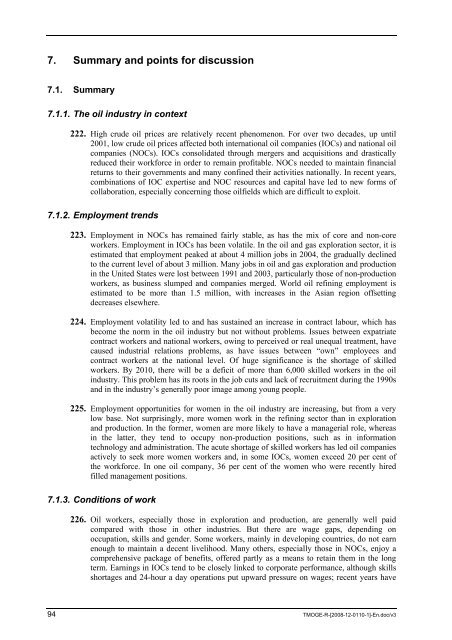wcms_161662
wcms_161662
wcms_161662
Create successful ePaper yourself
Turn your PDF publications into a flip-book with our unique Google optimized e-Paper software.
7. Summary and points for discussion<br />
7.1. Summary<br />
7.1.1. The oil industry in context<br />
222. High crude oil prices are relatively recent phenomenon. For over two decades, up until<br />
2001, low crude oil prices affected both international oil companies (IOCs) and national oil<br />
companies (NOCs). IOCs consolidated through mergers and acquisitions and drastically<br />
reduced their workforce in order to remain profitable. NOCs needed to maintain financial<br />
returns to their governments and many confined their activities nationally. In recent years,<br />
combinations of IOC expertise and NOC resources and capital have led to new forms of<br />
collaboration, especially concerning those oilfields which are difficult to exploit.<br />
7.1.2. Employment trends<br />
223. Employment in NOCs has remained fairly stable, as has the mix of core and non-core<br />
workers. Employment in IOCs has been volatile. In the oil and gas exploration sector, it is<br />
estimated that employment peaked at about 4 million jobs in 2004, the gradually declined<br />
to the current level of about 3 million. Many jobs in oil and gas exploration and production<br />
in the United States were lost between 1991 and 2003, particularly those of non-production<br />
workers, as business slumped and companies merged. World oil refining employment is<br />
estimated to be more than 1.5 million, with increases in the Asian region offsetting<br />
decreases elsewhere.<br />
224. Employment volatility led to and has sustained an increase in contract labour, which has<br />
become the norm in the oil industry but not without problems. Issues between expatriate<br />
contract workers and national workers, owing to perceived or real unequal treatment, have<br />
caused industrial relations problems, as have issues between “own” employees and<br />
contract workers at the national level. Of huge significance is the shortage of skilled<br />
workers. By 2010, there will be a deficit of more than 6,000 skilled workers in the oil<br />
industry. This problem has its roots in the job cuts and lack of recruitment during the 1990s<br />
and in the industry’s generally poor image among young people.<br />
225. Employment opportunities for women in the oil industry are increasing, but from a very<br />
low base. Not surprisingly, more women work in the refining sector than in exploration<br />
and production. In the former, women are more likely to have a managerial role, whereas<br />
in the latter, they tend to occupy non-production positions, such as in information<br />
technology and administration. The acute shortage of skilled workers has led oil companies<br />
actively to seek more women workers and, in some IOCs, women exceed 20 per cent of<br />
the workforce. In one oil company, 36 per cent of the women who were recently hired<br />
filled management positions.<br />
7.1.3. Conditions of work<br />
226. Oil workers, especially those in exploration and production, are generally well paid<br />
compared with those in other industries. But there are wage gaps, depending on<br />
occupation, skills and gender. Some workers, mainly in developing countries, do not earn<br />
enough to maintain a decent livelihood. Many others, especially those in NOCs, enjoy a<br />
comprehensive package of benefits, offered partly as a means to retain them in the long<br />
term. Earnings in IOCs tend to be closely linked to corporate performance, although skills<br />
shortages and 24-hour a day operations put upward pressure on wages; recent years have<br />
94 TMOGE-R-[2008-12-0110-1]-En.doc/v3














